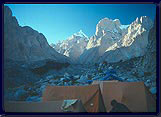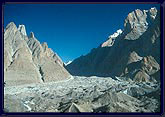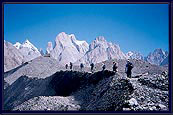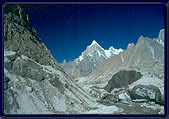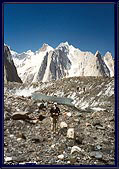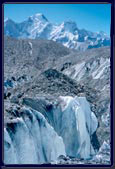We hiked up the Baltoro Glacier for four very tough days. The terrain was tricky, and the trail difficult to follow. Much boulder scrambling, and sliding on the icy patches that melted through the rocky moraine cover. Midday temperatures were roasting hot, but would fall quickly below freezing as soon as the sun set. We camped on sandy bits along side the glacier for two nights, and then the third night (and the four nights after that) we camped actually on the glacier itself, which is a whole new experience. Like sleeping on a large block of ice (which is of course what it was). But the scenery was spectacular, as you can see from the assortment of photos below.
Other images from the glacier call for a bit of explanation:
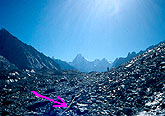 |
The Telephone Wire |
In the wild and ever-changing landscape, there was one thing that remained constant: the telphone wire that ran the length of the entire glacier. The Pakistani army has a series of desolate isolated outposts all the way up the glacier, since the head of the glacier forms part of the disputed border with India (the two armies have been shelling and shooting at each other periodically for the last 14 years). This telphone wire connects all the outposts and is their main means of communication. While this wire was a bit disonant in the primeval surroundings, it was often a comfort to see it as it meant that you were on the trail, which was quite easy to wander off at times if you lost sight of one of the porters who always knew the way.
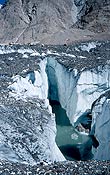 |
Deep Crack in the Glacier |
Underneath the layers of rock on the glacier was at least 300 feet of ice. This was not necessarily obvious as you were clambering over Volkswagon-sized boulders, but there were many spots where the ice in the glacier had pulled apart and its true nature would show through. These spots were awesome in their grandeur: to give some perspective, this wall of ice is about five stories high!
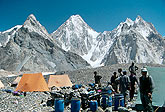 |
Setting up camp at Goro |
We camped directly on the glacier for five nights, one night on the way to Concordia, three nights at Concordia, and one night on the route back. Here, the porters are setting up camp at Goro II, our last night before reaching Concordia. You can see what an inhospitable environment this is for camping -- we were sleeping directly on a pile of rocks -- there was no way to clear off a smooth space for each tent as underneath the rocks were more rocks and underneath those rocks was ice. These were particularly cold nights, where you tried not to let any body parts stray off your therm-a-rest (the pad under your sleeping bag) lest you wake up in the morning with it frozen to the bottom of the tent.
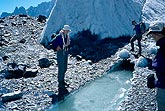 |
Frozen Crevasse |
Here we've stopped to inspect a crevasse in the glacier that had filled up with water, probably seeping up from the river of glacial melt that flowed far beneath the surface. You could not see the bottom of this crevasse, and a stone dropped into disappeared into the blackness. What's interesting to note is that although the temperature was in the high 90s farenheit/ 30s centigrade, and there was not a cloud in the sky to stop the burning rays of the sun, the surface of the water in this crevasse is still frozen! This was
cold water! In case you're wondering why we're all so seemingly bundled up in that heat, with trousers and long sleeves, this was for sun protection. There isn't an SPF available to stop you from burning to a crisp under that sun and at that altitude, where the air is thinner. At this point we were at about 14,000 feet.
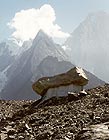 |
"Mushrooms" |
Another anomaly on the glacier were what looked like mushrooms. These were boulders -- often giant boulders -- which were raised up on an ice "platform" so that they looked as if they were on a pedestal. Actually, what has happened to create this is that the ice and rocks surrounding this particular boulder melted away, possibly because the boulder itself acted as a shade from the sun, and in receding left the rock on its own. At some point the underlying ice would not be strong enough to support it and it would topple. Hopefully not while anyone was standing right next to it.
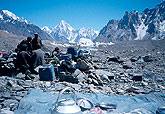 |
Lunch |
Lunch is served! The kitchen staff always managed to get ahead of us to set up and have lunch waiting for us when we arrived, despite the fact that we left while they were still clearing up from our breakfast, and had to dismantle and pack up the kitchen tent and all the supplies. Our fantastic cook was Mohammed Khan, who managed to make delicious meals out of what could be carried on the backs of the porters; because of their ability to pass us all on the trail without our even realizing it most of the time, we dubbed the kitchen crew "Mohammed Khan and his Flying Kitchen."
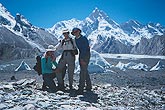 |
Almost there |
Sporting happy faces, Mark, Alison and Bob (and the rest of us) are pleased to be coming to the end of the Baltoro Glacier. The walking had been easier this day, as the glacier's surface had flattened out. But, as Bob put it quite succinctly, we were too tired to enjoy the easy walking! Note the huge "icebergs" growing out of the surface of the glacier. We were fast approaching our objective for the trip: Concordia. At 4,650 meters high (15,113 feet), Concordia is the area near the end of the Baltoro Glacier where it meets the Godwin-Austin Glacier, which leads to K2. It was given the name Concordia by a Frenchman, after the Place de la Concorde in Paris, because it is surrounded on all sides by great beauty, in this case an astounding selection of mountains from every angle. It has been called "The Throne Room of the Gods" for good reason.
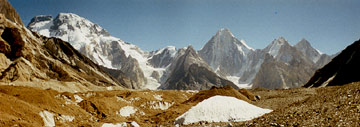 |
Approaching Concordia |
And here we approach Concordia at long last. The mountain straight ahead in the back is Gasherbrum IV, and the big wide mountain to the left in the rear is Broad Peak. You can not see K2 until you are standing in Concordia -- it's hidden by other mountains. It would be (way) off to the left in this photo.









